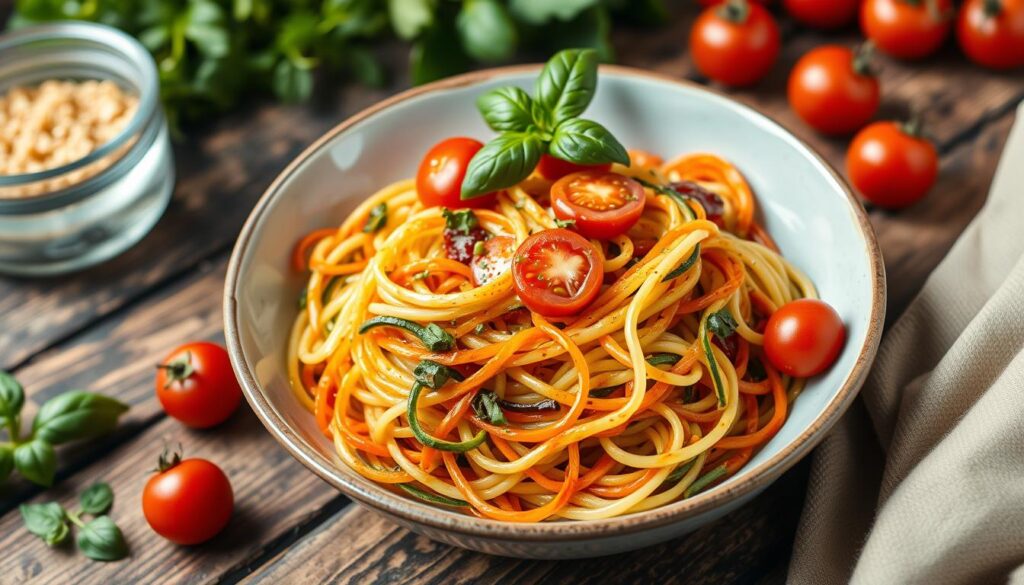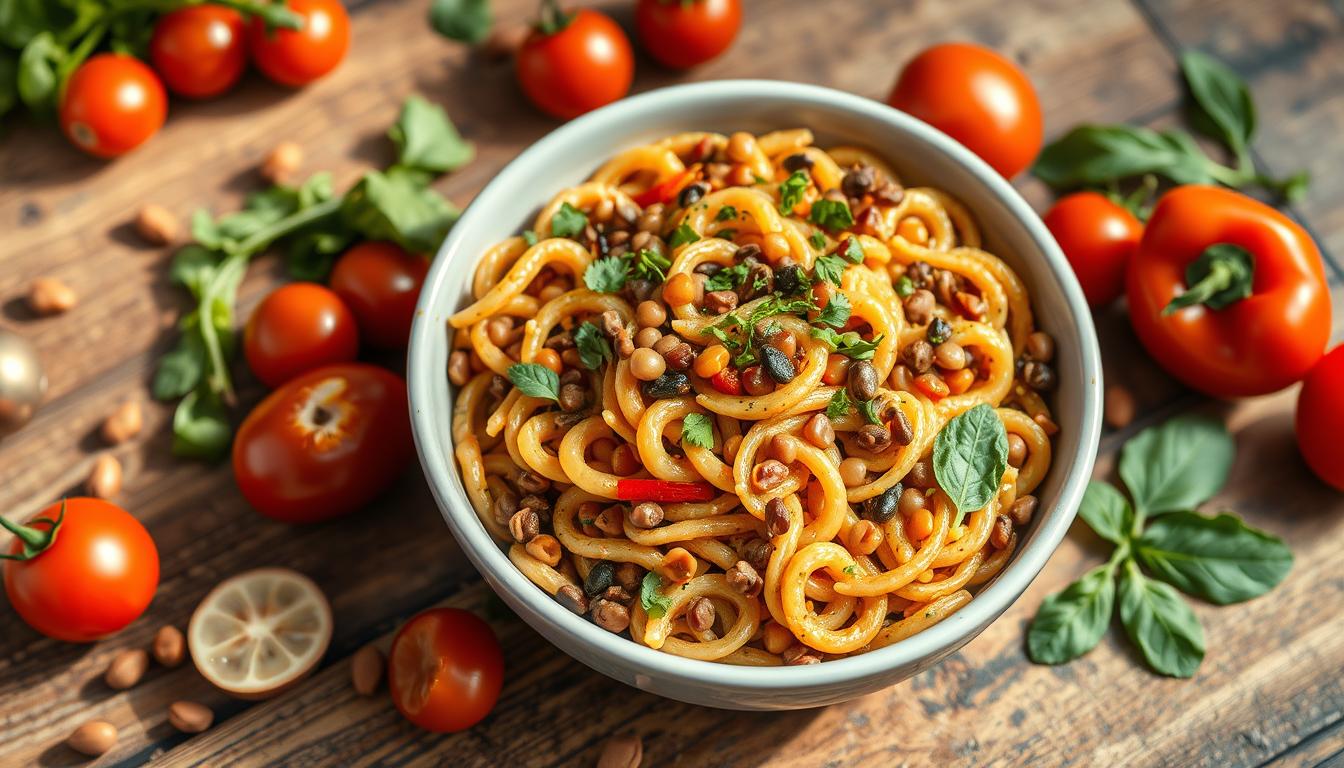Table of Contents
If you’re watching your carbs, traditional pasta might not be the best choice. But, you don’t have to miss out on your favorite Italian dishes. Explore healthy pasta alternatives and find low-carb pasta options that are both tasty and nutritious.
Imagine enjoying a plate of spaghetti without feeling guilty about the carbs. This dream is possible with new healthy pasta alternatives. They change how we enjoy pasta meals.
This guide will show you the top low-carb pasta options. You’ll learn about nutritious pasta substitutes like veggie noodles and legume pastas. These options meet different dietary needs and tastes. Get ready to enjoy your favorite Italian dishes while keeping your body healthy.
Low-Carb Pasta Alternatives
Many people are now choosing low-carb pasta alternatives for a healthier diet. These options are great for those on special diets and offer many health benefits. Let’s explore why switching to low-carb pasta is a good idea.
Benefits of Switching to Low-Carb Options
Instead of carbs, low-carb pasta options include extra protein and fiber. This aids in maintaining steady blood sugar levels and prolongs the feeling of fullness. Enjoy delicious dishes without the risk of an increase in blood sugar levels caused by wheat-based pastas.
Impact on Blood Sugar and Weight Management
Low-carb pasta is good for blood sugar control. Made from veggies, legumes, or grains, they have fewer net carbs. This means they don’t raise blood sugar as fast, which is great for people with diabetes or those who want healthy blood sugar levels.
The fiber and protein in low-carb pasta also help with weight management. They slow digestion and keep you feeling full longer. This can help you eat fewer calories, which is helpful for maintaining a healthy weight.
| Pasta Brand | Carbs per Serving | Fiber per Serving | Protein per Serving |
|---|---|---|---|
| Explore Cuisine Organic Edamame Spaghetti | 7g | 14g | 24g |
| Palmini Hearts of Palm Linguine | 4g | 2g | 0g |
| ThinSlim Foods Impastable Low Carb Pasta | 8g | 36g | 8g |
The table shows that low-carb pasta has less carbs but more fiber and protein. This makes them a great choice for a healthy, balanced diet.
Vegetable-Based Noodle Substitutes
Want some spaghetti that’s a little bit healthier? You can’t go wrong with veggie noodle alternatives. Despite being nutrient dense, they are low in carbohydrates. Enjoy all the flavor and none of the carbohydrates of traditional spaghetti with these plant-based alternatives.
Zucchini Noodles (Zoodles)
“Zoodles,” the cooking term for zucchini noodles, are simple and adaptable. Using a spiralizer, zucchini can be transformed into long, spaghetti-like strands. A nutritious substitute for pasta, they are rich in fiber, vitamins, and minerals.
Spaghetti Squash
When cooked, spaghetti squash naturally creates long strands that resemble spaghetti. The flavor is subtle and sweet. Antioxidants, vitamins, and minerals abound in this low-carb, low-calorie vegetable.
Butternut Squash Spirals
Butternut squash spirals are another great option. Spiralizing or thinly slicing butternut squash creates noodle-like strands. It adds a sweet flavor to dishes and is a good source of fiber, vitamins, and minerals.
These vegetable noodle substitutes are not only healthy but also help reduce carb intake. Try zucchini noodles, spaghetti squash, and butternut squash spirals to find your favorite low-carb pasta option.
Legume and Grain-Based Pasta Options
If you want to cut down on carbs but still love pasta, try legume and grain-based options. These pastas are healthier than regular wheat pasta. They also pack a punch of nutrients.
One of the best options is chickpea pasta, such as Banza. Each serving contains fourteen grams of protein. This makes it a great choice for those looking for more protein. Chickpea pasta tastes and feels like regular pasta, but with fewer carbs.
Lentil pasta is another protein-packed option. It has a unique earthy flavor. This gluten-free pasta is a smart way to get more fiber and nutrients in your meals.
Quinoa pasta is perfect for those who want a complete protein. It has a mild, nutty taste and a texture that’s just right. Quinoa pasta can easily replace traditional pasta in your dishes.
| Pasta Type | Protein (g per serving) | Fiber (g per serving) | Net Carbs (g per serving) |
|---|---|---|---|
| Chickpea Pasta | 14 | 8 | 26 |
| Lentil Pasta | 15 | 3 | 30 |
| Quinoa Pasta | 5 | 4 | 41 |
| Whole Wheat Pasta | 6 | 5 | 34 |
| White Pasta | 7 | 2 | 43 |
Legume and grain-based pastas are often gluten-free. They’re also packed with nutrients. Adding these options to your diet can make pasta healthier and more enjoyable.
Healthy Pasta Alternatives for Different Diets
Many pasta alternatives have come up for healthier eating. They fit different diets like keto, gluten-free, and vegan. You can still enjoy pasta while meeting your nutritional needs.
Keto-Friendly Options
On a keto diet? Try keto pasta like shirataki noodles and zucchini noodles. Shirataki noodles are almost carb-free, perfect for pasta lovers. Zucchini noodles offer a similar feel but with fewer carbs.
Gluten-Free Choices
Gluten-free dieters have lots of options. You can find gluten-free pasta made from rice, legumes, or veggies. Try rice pasta, legume pasta, or veggie noodles like spaghetti squash.
Vegan Alternatives
Looking for vegan pasta? There are many plant-based choices. Edamame spaghetti, black bean pasta, and veggie noodles are great. They’re good for vegans and offer a healthy pasta experience.
No matter your diet, there’s a healthy pasta option for you. Enjoy pasta’s comfort and versatility while staying healthy.
Shirataki and Konjac Noodles Guide
Discover the world of low-carb pasta with shirataki noodles and konjac pasta. These zero-carb noodles come from the konjac yam. They offer a tasty pasta experience with a unique twist.
Shirataki noodles, also called “miracle noodles,” have almost no calories and zero net carbs. They’re perfect for keto or low-carb diets. You can find them in various shapes and sizes from brands like It’s Skinny and Miracle Noodle.
Shirataki noodles are simple to make. After a quick rinse and drain, you may toss them with whatever seasonings or sauces you choose. They are great flavor absorbers, so your meals will taste great without the guilt.
The texture might be different at first, but many enjoy shirataki noodles as a zero-carb pasta option. Try different cooking methods and flavors to find your favorite low-carb noodle dish.
Konjac pasta is another low-carb, high-fiber choice. Like shirataki noodles, it’s made from the konjac root. It’s a healthier option for your pasta cravings.
Check out the many shirataki and konjac pasta options. Start a culinary journey that meets your dietary needs without losing flavor or satisfaction.
Plant-Based Protein Pasta Solutions
Trying to find a pasta dish that is less unhealthy? An excellent option are pastas made with plant-based proteins. In addition to being rich in protein and other nutrients, they have a delicious texture.
Chickpea Pasta Benefits
One of the best protein-rich pasta options is chickpea pasta, such as Banza. Protein content is approximately 14 grammes per serving. The protein content is double that of ordinary pasta, while the fiber content is triple that. For individuals who are watching their gluten intake, this is an ideal option.
Lentil Pasta Nutrition
Lentil-based pastas, like Tolerant Foods, are nutritional powerhouses. They’re loaded with protein, fiber, and iron. This makes them a better choice than regular pasta. They’re also often gluten-free, fitting many diets.
Quinoa Pasta Properties
Quinoa pasta, from Ancient Harvest, is a high-protein pasta with all nine essential amino acids. It’s a complete protein source. It’s also gluten-free and has a unique, nutty taste. Its versatility makes it ideal for plant-based or gluten-free diets.
| Pasta Type | Protein (g) | Fiber (g) | Carbs (g) |
|---|---|---|---|
| Chickpea Pasta | 14 | 8 | 25 |
| Lentil Pasta | 13 | 7 | 27 |
| Quinoa Pasta | 10 | 5 | 34 |
| Refined Wheat Pasta | 7 | 2 | 43 |

Cooking Tips and Preparation Methods
Creating tasty low-carb pasta alternatives needs some cooking technique practice. Unlike regular pasta, many low-carb options like zucchini noodles and shirataki noodles need special cooking methods. This ensures they have the right texture and taste.
For zucchini noodles, don’t overcook them to avoid mushiness. A quick sauté or steam for 1-2 minutes is enough. For shirataki noodles, rinse and dry-fry them first. This removes any odd smell or jellyfish texture.
Legume-based pastas, like chickpea or lentil pasta, cook faster than regular pasta. Watch them closely and check for doneness a bit earlier.
- Try different cooking times and methods to get the perfect texture for your low-carb pasta.
- Many vegetable and grain-based noodles are great in both hot and cold dishes, making meal prep easy.
Learning the right cooking techniques for low-carb pasta alternatives lets you enjoy tasty pasta dishes. Plus, it supports your health and wellness goals.
| Pasta Alternative | Cooking Tips | Texture and Flavor |
|---|---|---|
| Zucchini Noodles | Sauté or steam for 1-2 minutes to avoid mushiness | Firm, noodle-like bite |
| Shirataki Noodles | Rinse and dry-fry to eliminate odor and jellyfish-like texture | Chewy, neutral flavor |
| Legume-Based Pastas | Cook for a shorter time than traditional wheat pasta | Firm, with a slightly nutty or earthy taste |
Nutritional Comparison of Pasta Alternatives
There are many pasta options beyond traditional wheat-based ones. Each has different calorie counts, protein, and fiber levels. Knowing these details helps you choose the right pasta for your diet.
Calorie Content Analysis
“Zoodles” made of zucchini and spaghetti squash are two examples of vegetable noodles that are low in calories (less than 50 per serving). About 200 calories are contained in 2 ounces of traditional pasta. The calorie content of pastas made from legumes, such as chickpeas or lentils, is moderate.
Protein and Fiber Levels
Alternative pastas often have more protein than regular pasta. Legume-based options have 14 to 24 grams of protein per serving. They also have more fiber, which is good for your digestive health and keeps you full. Shirataki noodles, from the konjac plant, have almost no calories and carbs.
| Pasta Type | Calories (per 2 oz) | Protein (grams) | Fiber (grams) |
|---|---|---|---|
| Traditional Wheat Pasta | 200 | 7-8 | 2 |
| Whole Wheat Pasta | 200 | 7-8 | 4-5 |
| Zucchini Noodles | 20-50 | 1-2 | 1-2 |
| Chickpea Pasta | 190-300 | 14-24 | 7-9 |
| Lentil Pasta | 190-300 | 14-24 | 7-9 |
| Shirataki Noodles | 0-20 | 0-1 | 0-2 |
These nutritional differences help you pick pasta alternatives that fit your dietary needs. Whether you want low-carb, high-protein, or more fiber, there’s a pasta for you.
Conclusion
The world of healthy pasta alternatives has grown a lot. Now, there are many options for those who want to eat less carbs or follow special diets. You can find everything from zucchini noodles and spaghetti squash to chickpea and lentil pastas.
Trying these low-carb pasta alternatives lets you enjoy pasta dishes without feeling guilty. They help control blood sugar, aid in weight management, and add more nutrients to your diet. The demand for gluten-free and healthy eating has led to many new pasta choices.
If you’re trying to eat fewer carbs, get more fiber and protein, or just try new foods, you’re in luck. Healthy pasta alternatives offer a wide range of choices. By adding these options to your meals, you can start a tasty journey towards a healthier diet.

